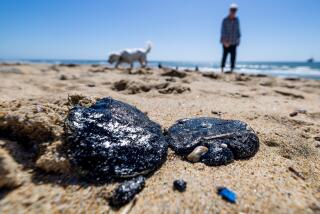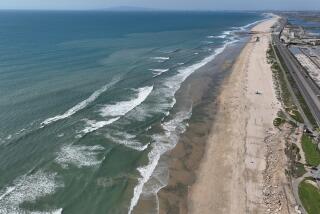Oil Residue Stains Wetlands, but Damage Is Believed Minimal
- Share via
HUNTINGTON BEACH — A wafer-thin layer of oily residue glistened in the waterways and ringed the nesting islands of the Huntington Beach Wetlands on Monday, but biologists expressed optimism that damage might be minimal to the 25-acre wildlife habitat near the Santa Ana River mouth.
“I don’t think that we’ve got permanent damage,” said Gary Gorman, executive director of the Huntington Beach Wetlands Conservancy, an environmental group that is restoring the once-neglected salt marsh. “I think the oil that got in there will eventually dissipate.”
But the presence of oil in the ecologically delicate refuge, and the sight of dozens of cleanup workers on Monday dabbing at the fouled waterways that lead to the open ocean half a mile away, was disheartening for environmentalists. Protecting coastal wetlands from 394,000 gallons of oil that spilled from the ruptured tanker American Trader on Feb. 7 had been a priority.
Efforts to seal off marshes and refuges that dot Orange County’s coast had largely succeeded until Sunday, when an extremely high morning tide combined with large swells to demolish a sand dike and snap a series of protective booms, sending waves of frothy brown residue up the Talbert Channel to the wetlands.
The amount of oil that contaminated the wetlands is relatively small--less than 10 gallons by one estimate. However, some impact is expected, and several experts suggested that even a little oil could be damaging because the newly restored marsh is small and underdeveloped.
“I think the oil that’s in there will probably do some unquantifiable damage,” Gorman said. “It’ll coat the plants. Some of them will die. Some of it will probably get into the mud. Some of the invertebrates will probably die.”
Scores of migrating waterfowl use the refuge to feed and nest, including a pair of endangered species, the California least tern and Beldings savannah sparrow.
After inspecting the marsh, Duane Maxwell, a water quality biologist for the state Department of Fish and Game, concluded: “I don’t think it’s badly oiled.” Most of the “light sheen” was packed against the eastern edge of the marsh and Maxwell said, “if they work at it, I don’t think it will be difficult” to clean up.
Besides deploying about 75 cleanup workers to the marsh, British Petroleum, which owned the spilled oil, used three large vacuum trucks with long hoses to skim the sheen from the water. But no decision was reached on whether to mop up the residue that surrounded the flat nesting islands like a bathtub ring. Environmentalists warned that walking on the mud flats could cause more harm.
British Petroleum officials said that Sunday’s tidal surge ironically helped scrub oil-coated rocks in the jetties that separate the Talbert Channel from the Santa Ana River. As a result, the company predicted that cleanup efforts in the channel and around the river mouth may be completed within two weeks--rather than four to six weeks as previously estimated.
“Nobody wanted to see that wetlands harmed,” company spokesman Chuck Webster said. “But Mother Nature may have delivered a blessing in disguise. Those waves in a single day did what it might have taken us a week or more to accomplish.”
Approximately 10 miles of beaches--in various stages of cleanup--remained closed Monday from the Newport Pier north to Bolsa Chica State Beach at Warner Avenue.
In a move toward reopening beaches, technicians from an Anaheim-based firm were testing dozens of samples of sand for hydrocarbons and possible carcinogens. Med-Tox Associates Inc. has been hired by British Petroleum to scoop up samples of sand every 500 feet from Corona del Mar to Anaheim Bay. The testing, required by local municipalities and county health officials, is the last step before beaches can be reopened to the public.
More to Read
Sign up for Essential California
The most important California stories and recommendations in your inbox every morning.
You may occasionally receive promotional content from the Los Angeles Times.










